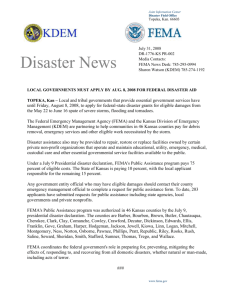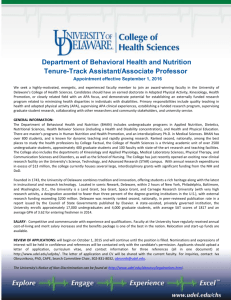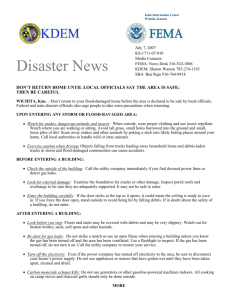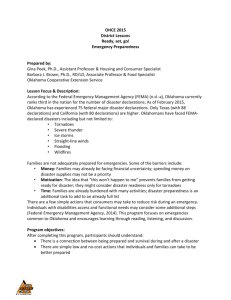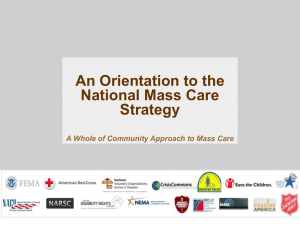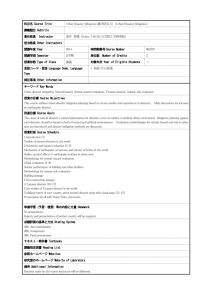Katrina – stuff - Civil and Environmental Engineering
advertisement
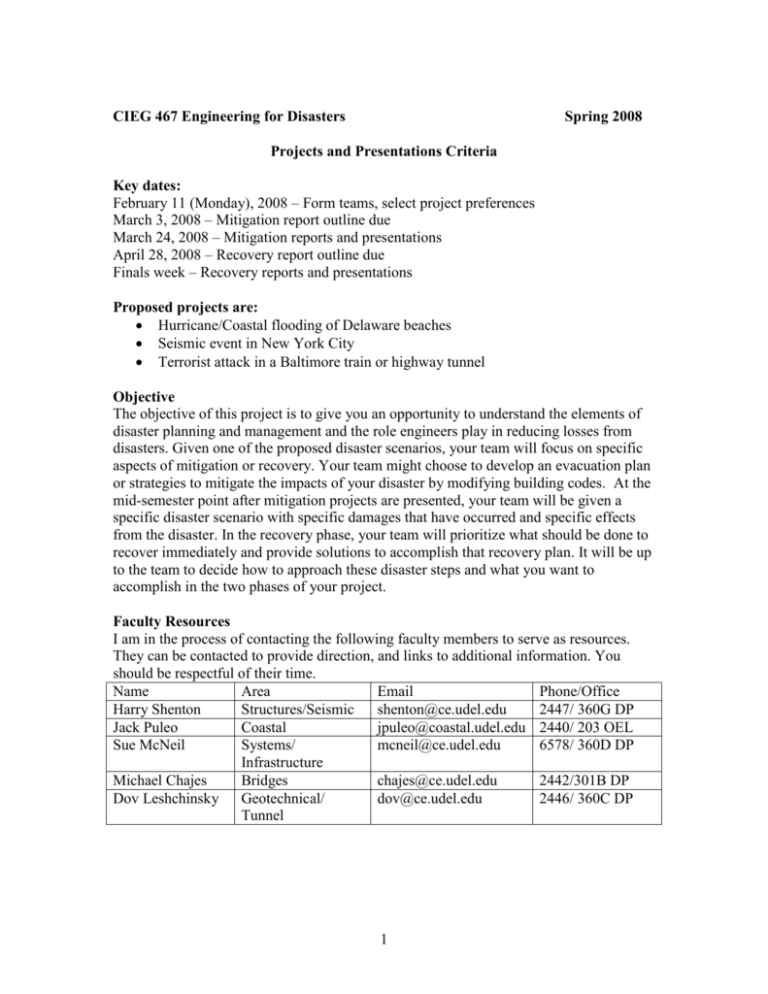
CIEG 467 Engineering for Disasters Spring 2008 Projects and Presentations Criteria Key dates: February 11 (Monday), 2008 – Form teams, select project preferences March 3, 2008 – Mitigation report outline due March 24, 2008 – Mitigation reports and presentations April 28, 2008 – Recovery report outline due Finals week – Recovery reports and presentations Proposed projects are: Hurricane/Coastal flooding of Delaware beaches Seismic event in New York City Terrorist attack in a Baltimore train or highway tunnel Objective The objective of this project is to give you an opportunity to understand the elements of disaster planning and management and the role engineers play in reducing losses from disasters. Given one of the proposed disaster scenarios, your team will focus on specific aspects of mitigation or recovery. Your team might choose to develop an evacuation plan or strategies to mitigate the impacts of your disaster by modifying building codes. At the mid-semester point after mitigation projects are presented, your team will be given a specific disaster scenario with specific damages that have occurred and specific effects from the disaster. In the recovery phase, your team will prioritize what should be done to recover immediately and provide solutions to accomplish that recovery plan. It will be up to the team to decide how to approach these disaster steps and what you want to accomplish in the two phases of your project. Faculty Resources I am in the process of contacting the following faculty members to serve as resources. They can be contacted to provide direction, and links to additional information. You should be respectful of their time. Name Area Email Phone/Office Harry Shenton Structures/Seismic shenton@ce.udel.edu 2447/ 360G DP Jack Puleo Coastal jpuleo@coastal.udel.edu 2440/ 203 OEL Sue McNeil Systems/ mcneil@ce.udel.edu 6578/ 360D DP Infrastructure Michael Chajes Bridges chajes@ce.udel.edu 2442/301B DP Dov Leshchinsky Geotechnical/ dov@ce.udel.edu 2446/ 360C DP Tunnel 1 Background Materials The following links are intended to give you a start on defining the problem (the potential disaster) and identifying background material. They are not intended to be complete. Baltimore Tunnels: Maryland Transportation Authority http://www.mdta.state.md.us/mdta/servlet/dispatchServlet?url=/About/about.jsp Baltimore Tunnel Fire 2003. http://www.usfa.fema.gov/downloads/pdf/publications/tr-140.pdf (FEMA Report) http://www.state.nv.us/nucwaste/news2003/pdf/nas_resnikoff.pdf (pdf of powerpoint -includes chronology) http://www.itsdocs.fhwa.dot.gov/JPODOCS/REPTS_TE/13754.html Kennedy School case studies. http://ksgcase.harvard.edu/content/how_to_order.html Seismic Event in New York City Cities at Risk for Earthquakes http://tlc.discovery.com/convergence/quakes/articles/citiesatrisk_04.html New York City Area Consortium for Earthquake Loss Mitigation http://nycem.org/background.asp Seismic Vulnerability of New York State: Code Implications for Buildings, Bridges, and Municipal Facilities http://mceer.buffalo.edu/infoservice/faqs/jacob.asp Waiting for the big one: Is New York prepared for earthquakes? http://jscms.jrn.columbia.edu/cns/2005-02-15/hussain-earthquake Coastal Flooding In Delaware Delaware Department of Natural Resources and Environmental Control (DNREC) Coastal Zone Information http://www.dnrec.delaware.gov/info/Coastal.htm Beaches http://www.dnrec.state.de.us/DNREC2000/Beaches.htm Emergency Response http://www.dnrec.state.de.us/DNREC2000/Emergency.asp Delaware Flooding - Declared February 13, 1998 http://www.fema.gov/news/event.fema?id=527 Delaware Severe Storms, Tornadoes, and Flooding from the remnants of Hurricane Jeanne - Declared November 15, 2004 http://www.fema.gov/news/event.fema?id=3923 Delaware Emergency Management Agency (DEMA) – Disaster Preparedness http://www.state.de.us/dema/services/disaster_prep.shtml 2 Requirements for Project Reports and Presentations Project Report Outlines The outline should reflect the elements of the grading sheet as outlined below. Like the proposal outline, the purpose of the project outline is to get you thinking about the report and provide an opportunity for the course coordinators to provide feedback. Specific group members should be assigned responsibility for specific sections of the report. These assignments should be part of the outline. You should be able to easily develop a presentation from the outline and the report. Rough Draft (this is not a required deliverable) The rough draft should integrate much of what is provided in the outline and should represent about a 60-75% complete product. This is an opportunity to get feedback from the instructor without the requirement of having this step be part of the grade. Taking advantage of this step is strongly encouraged. Written Reports The two project reports should describe the problem you addressed, background material, approach, the final results or product, any additional work required and references. Reports should have a clear beginning, middle and end. Start with a description of what you’re going to say, say it, then end with a summary of what you said. Inclusion of photos, graphics, maps, etc always helps tell some parts of a story so include those where appropriate. There is a 20 page limit to the reports. The cover page and the table of contents are not included in the 20 pages. Final reports will be graded according to the attached grading sheet. Please attach this sheet to your group’s project. Presentations The two project presentations should be about 30 minutes in length with an additional 10 to 15 minutes for questions. Each member of the group must have a role in the presentation. Visual aids should be used to support the presentation. Please have copies of the presentation for the audience so others can follow and have a place for notes, etc. Grading (as a % of course grade), each phase is 40% of course grade Report Outline – 5% Final report – 20% Final Presentation – 15% TOTAL – 40% 3 CIEG 467 Engineering for Disasters Spring 2008 Project Grading Sheet Please attach to the front of your project Group Members: ________________________________________________ Category Cover sheet / Table of Contents Abstract or Executive Summary Introduction Points Max Points 5 5 5 Objectives 5 Background 10 Approach 10 Findings/ results/ products 15 Critique/ Discussion/ Directions for future work References 10 Completeness 10 Technical quality 10 Presentation quality (written document) 10 5 100 4 Comments
